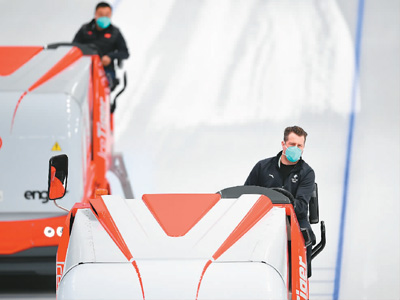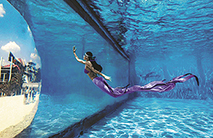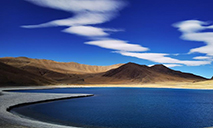National Speed Skating Oval aims to produce “fastest” ice for skaters at Beijing 2022

Chinese and foreign ice makers patch up a skating track during a competition event. (Xinhua/Zhang Chenlin)
Producing fast and environmentally-friendly ice surfaces for skaters has always been the goal in the construction of the National Speed Skating Oval (NSSO), or the “Ice Ribbon”, which will stage speed skating competitions during next year’s Winter Olympics.
Last month, the venue won praise for its high-quality competition facilities from both Chinese and foreign athletes during a speed skating test event.
“The venue’s ice-making process applies carbon dioxide, with Chinese and foreign engineers having spent only 10 days to finish the ice-making process for the venue before the event,” said Wu Xiaonan, director of the operations team for the NSSO.
Feng Gang, vice manager of the planning and development department at the NSSO, disclosed that when they started to design the venue, experts suggested that they adopt an environmentally-friendly ice-making technology that is more commonly used. In the end they chose to adopt the use of carbon dioxide transcritical direct cooling technology, which is a more advanced technology and one that consumes less energy.
“China’s carbon dioxide transcritical direct cooling technology is at the advanced international level. Plus, as the country aims to encourage 300 million people to take part in snow and ice sports, it’s time that we stop using traditional technologies when it comes to making ice for skating venues,” said Ma Jin, who is in charge of the design of the venue’s ice-making system. Ma added that it was the first time that the carbon dioxide technology was applied for ice-making at a Winter Olympics venue.
With an ice surface area of 12,000 square meters, the site’s effect in reducing carbon emissions is equivalent to planting over 1.2 million trees. In addition, the system can achieve a temperature difference of 0.5 degrees Celsius or less across the ice surface, which provides strong support for top-level ice performances.
Skaters commonly break records on high-altitude tracks, where thinner air can give them the vital one-hundredth-of-a-second edge in pursuit of glory. However, according to Wu, the NSSO aims to produce the fastest ice possible for skaters in areas at lower altitudes. To make this possible, they invited Canadian ice-making expert Mark Messer and his team to take part in ice-making for the venue.
Messer’s team has previously prepared rinks for five Winter Olympic Games. However, applying the new technology was a challenge for them. There were quite a lot of details that had to be paid attention to, including the proportion of pure water and tap water used to generate ice, which had to reach an ideal mix, while the humidity and temperature levels at the venue had to be repeatedly adjusted, among other concerns.
The cooperation with Messer’s team has benefited Chinese ice-making engineers. During a third round of ice-making, which took place in April 2021, it took the Chinese ice makers seven days to independently prepare ice for a track designed for training and for use as a multifunction venue at the NSSO.
Apart from the Chinese ice makers, fellow students from Beijing Polytechnic are also learning and taking part in the ice-making process at the venue. In 2019, the NSSO, the National Aquatics Center and Beijing Polytechnic jointly launched a project to cultivate professionals skilled in ice-making and ice maintenance for the Winter Olympics.
Messer expressed that along with the development of winter sports, China is set to build a talent pool for ice-making in the future, which will become an important legacy for the Beijing 2022 Winter Games.
Photos
Related Stories
- Test event for 2022 Winter Olympics employs robots to ensure safe, convenient services
- Beijing Winter Olympics venue equipped with coffee-making robots, logistics robots
- Foreign media welcome at Olympics
- Cooperation on winter sports boosts bilateral ties between China and Finland: Finnish ambassador
- Building Winter Olympics dreams for China
- Chinese consul-general in Sydney publishes signed article on Beijing 2022 Winter Olympics in the Australian Financial Review
Copyright © 2021 People's Daily Online. All Rights Reserved.










